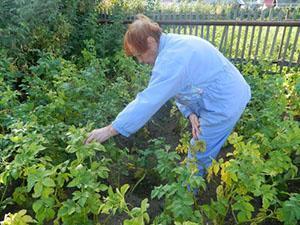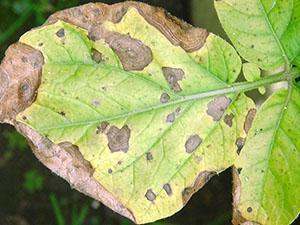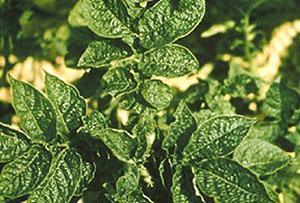Do you know why the lower leaves of potatoes turn yellow?
 Today, no Russian family can imagine their diet without potato dishes. This important food product is in demand all over the world not only because of its cheapness, but also due to its beneficial taste. Growing potatoes is one of the main occupations of many farmland. However, in order to get a good harvest of a tuberous plant, meticulous care of each bush is necessary. This will help to timely identify and eliminate many potato diseases caused by fungi, bacteria, viruses, parasitic insects and worms.
Today, no Russian family can imagine their diet without potato dishes. This important food product is in demand all over the world not only because of its cheapness, but also due to its beneficial taste. Growing potatoes is one of the main occupations of many farmland. However, in order to get a good harvest of a tuberous plant, meticulous care of each bush is necessary. This will help to timely identify and eliminate many potato diseases caused by fungi, bacteria, viruses, parasitic insects and worms.

The main factors affecting yield
The most frequently asked question among many novice gardeners is why do the lower leaves of potatoes turn yellow? Experienced farmers know the correct answer. They are ready to suggest what to do in this case and what are the main reasons for the unpleasant phenomenon.
Monitor the condition of the soil. Lack of moisture and air in the surface layer of the soil can lead to yellowing of the lower leaves. The plant is forced to take all the nutrients from them to maintain its normal life.
Hot, dry weather strongly affects any plant, and potatoes are no exception to this rule. The first reaction to drought is yellowed lower leaves. However, intense watering you shouldn't get carried away either. The resulting crust on the soil can cause the plant to simply suffocate. For the same reason, heavy rains can also affect the appearance of yellow leaves, after which caring gardeners loosen the soil.
In some potato varieties, the lower leaves turn yellow in June. If a previously unfamiliar variety was planted, then you should not be very surprised at this phenomenon.
Varieties of viral diseases of potatoes
 The most dangerous potato diseases are viral. The thing is that they are completely resistant to treatment. The main symptoms of the disease are potato leaves curling, yellowing and wilting. But they may differ depending on the growing conditions, the type of virus and the variety of potatoes. Infection occurs through contact with an infected and healthy plant or with the help of insects.
The most dangerous potato diseases are viral. The thing is that they are completely resistant to treatment. The main symptoms of the disease are potato leaves curling, yellowing and wilting. But they may differ depending on the growing conditions, the type of virus and the variety of potatoes. Infection occurs through contact with an infected and healthy plant or with the help of insects.
The most effective method of fighting the disease is the timely removal of diseased plants. It is advisable to do this before the tops of neighboring plants begin to touch. You also need to make sure that only healthy tubers are planted and insects that can become carriers of the disease are destroyed. If you follow all the precautions, then the harvest will turn out to be much richer than with a frivolous attitude.
The two most common types of viral potato disease are:
 Leaf roll virus. It strongly affects the quality and quantity of tubers and provokes a very serious disease. Infection with this virus is primary and secondary. In the primary case, the leaves of the upper part of the plant turn red at the edges, curl and become tough. With the secondary, the same symptoms appear, but with the lower leaves. Tubers are affected by network necrosis.Controlled by planting healthy tubers, removing infested plants and killing harmful insects.
Leaf roll virus. It strongly affects the quality and quantity of tubers and provokes a very serious disease. Infection with this virus is primary and secondary. In the primary case, the leaves of the upper part of the plant turn red at the edges, curl and become tough. With the secondary, the same symptoms appear, but with the lower leaves. Tubers are affected by network necrosis.Controlled by planting healthy tubers, removing infested plants and killing harmful insects.- Alfalfa Mosaic Virus. This virus is not as dangerous as the previous one, but it is also very unpleasant for potatoes. It is the reason why potato tops turn yellow. This, in turn, lowers the chlorophyll content of the plant's leaves and results in a poor yield for that plant. The virus can persist in tubers, so when planting, they must be carefully selected to minimize the number of diseased plants
Potato parasites
Parasites are mainly represented by three types of nematodes:
- Golden.
- Stem.
- Gallic.
Golden nematode is very dangerous for potatoes. When infected with this parasite, the amount of the harvested crop can drop by half. It mainly affects the root system of the plant. Accordingly, the tops begin to turn yellow and wither, which does not allow the tubers to fully form and reduces their number. But visible symptoms can only appear with a strong infection. If it manifests itself in a weak form, then it can only be detected by digging a bush and examining the roots and tubers.
 To avoid infection with this parasite, it is better to use varieties that are resistant to it. But every 3-4 years they should be alternated with an unstable variety. This is done to prevent the parasite from adapting. You can also use the cultivation of legumes or corn on this site.
To avoid infection with this parasite, it is better to use varieties that are resistant to it. But every 3-4 years they should be alternated with an unstable variety. This is done to prevent the parasite from adapting. You can also use the cultivation of legumes or corn on this site.
 The stem nematode enters the tuber from the side of the stem. After that, the tuber begins to deteriorate - it cracks, rot appears. Accordingly, this fruit is already losing its edible properties and it remains to be thrown away.
The stem nematode enters the tuber from the side of the stem. After that, the tuber begins to deteriorate - it cracks, rot appears. Accordingly, this fruit is already losing its edible properties and it remains to be thrown away.
 Gall nematode also settles in tubers, roots and in the underground part of the stem. Plants affected by them stop growing and gradually wither. In places of defeat, thickenings are formed, which increase and merge with each other. This leads to damage to the protective cover of the root or tuber and the penetration of microorganisms there, after which the affected area begins to rot.
Gall nematode also settles in tubers, roots and in the underground part of the stem. Plants affected by them stop growing and gradually wither. In places of defeat, thickenings are formed, which increase and merge with each other. This leads to damage to the protective cover of the root or tuber and the penetration of microorganisms there, after which the affected area begins to rot.
Fungal diseases
Fungal diseases are also one of the reasons why the lower leaves of potatoes turn yellow. One of these diseases is late blight... Below is a photo of this disease of potato tops, on which all the signs of the fungus are clearly visible.
1 - affected leaf: 2 - affected shoots; 3 - affected eyes; 4 - the affected tuber on the left, on the right it is in section
The main sources of disease are infected planting tubers and residues of infected plants in the ground. Late blight can reduce the yield by half or even more. In order to prevent, the tops are sprayed with fungicides when the buds are just beginning to appear.
To reduce the likelihood of infection with this fungus, you can spray the tops with a solution of potassium permanganate and garlic. To do this, take one and a half glasses of garlic pulp and infuse for 24 hours in a bucket of water. Then this infusion is filtered and 1.5 grams of potassium permanganate is added to it. Processing should be carried out in the evening. The first time it is carried out 14 days after disembarkation and is repeated after 10 days.
Fight against potato diseases - video
https://www.youtube.com/watch?v=-hnGo0ZX8Zs
If the lower leaves in a potato field have begun to turn yellow, there are many possible factors to add up. If yellowing manifested itself at the very beginning of the development of the bush, then the reason may be a lack of moisture, maybe there is not enough nutrition. If there is also a marginal burn on the leaves, then the plants need to be fed, there is little potassium and magnesium. This can be a viral disease if the bush is clearly lagging behind in growth from its neighbors. Maybe the virus came from seeds. Such a bush must be removed. Nests with uncharacteristic leaves and the yield will be small, and will be breeding grounds for diseases.In order to protect seeds from viruses and diseases, I do not take potatoes from a common heap. I select the best bushes for seeds and dig them out in advance, before general harvesting. I green this potato slightly and store it separately from the food supply. Therefore, the rejection of bushes is small. Today it is dangerous to buy seed material, the golden nematode has already spread strongly, and this is a quarantine pest. Any seeds need to be pickled before using to keep the garden from getting infected.